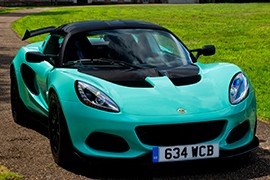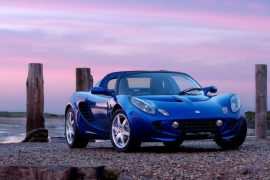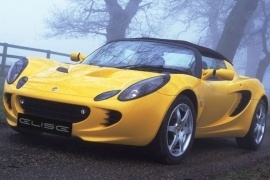
LOTUS Elise
Generations Timeline, Specs and Pictures

The Elise was around for almost two decades and the 2017’s model was faster and lighter than its predecessor.
The Elise Cup released in 2017 was also named the Cup 260 as it was based on the Cup 250, a model released in 2016.
The exterior upgrades were not that visible at a first glance, but looking with greater attention, the new model featured a redesigned front bumper that had a wider and taller center grille. Most of the visual upgrades were not completely to improve its design, although it made it look more aggressive, they had their aerodynamic purpose and reduced aerodynamic lift. The Cup 260 kept the aggressive carbon-fiber side skirts from the Cup 250.
The sports car had ultra-lightweight 16-inch alloys at the front and 17-inch alloys in the rear, both featuring Yokohama Advan Neova tires.
The interior carbon-fiber seats wrapped up in black Alcantara with door panel matching stitching, either red or yellow.
The Elise Cup featured a 1.8-liter supercharged engine developing 250 horsepower with 188 pound-feet of torque. The car reached 60 mph in 3.8 seconds and finished the Hethel track in one minute and 32 seconds.
The production of the Cup 260 was limited to only 30 units with a higher price than the Cup 250.

After a few other final editions, Lotus decided to retire the Elise in a true Final Edition roadster that added a few extra ponies and added some changes to the car’s look both in and outside.
It might be hard to imagine how the Elise survived on the market for a quarter of a century. It was revealed in 1996, and it went through constant upgrades over time, but in essence, it remained the same bare-chassis sports car. It was the car that saved the Lotus brand and made it great again. No pun intended.
The major changes were for the colors from the outside, which evoked the original paint schemes of the original, 1996, Elise. Lotus offered the Final Edition 240 in Azure Blue, Black, and Racing Green. As a statement for the final 2021 edition, Lotus added “Final Edition 240 Sport” decals on the front fenders. There was no massive rear wing in the back.
Inside, the biggest change was the TFT instrument panel that replaced the analog dials. It featured a two-screen display, one for regular street use and another one for racing, on the tracks. A thick and slightly wider steering wheel clad in leather and Alcantara helped the driver to keep the car under control via the unassisted steering. Between the seats, the carmaker left the gear-box linkages exposed as a spectacular metallic sculpture.
The engine was the same 1.8-liter supercharged four-mill tuned to provide 240 hp. Yes, the Final Edition Sport 240 was heavier than the original 1996 Elise, but it was still a light sports car by any means, and the engine was there just to push it from one corner to another.

While it is not a genuine third generation, even though Lotus called it Series 3, the 2010 Lotus Elise shows some important improvements over the Series 2 model.
There are new headlights, new engines, and new gearboxes.
Since the Series 1 chassis was one of the best in its class, with its hydroformed aluminum structure and glued together, it was hard to change something to it. But, with a little help from the GM, Lotus was able to do some modifications to comply with the new safety regulations. That was, basically, the most important update for the Series 2.
Then, in 2010, Series 3 came with the smaller displacement engine of 1.6-liter from Toyota. It was a rev-happy unit that boosts out 136 hp, which was decent for the very light sports car. And then, they installed a 1.8-liter engine naturally aspirated or supercharged.
Inside, there are the same two tight seats that hold their occupants fixed in place, a manual gearbox and, as an option, an AC unit. Other than that, everything is kept to basic. It shows its intention to be a true driver’s car and not a vehicle that someone would drive on a daily commute. The 1.6-liter unit combined with its lightweight makes it a very fuel-efficient car. But its hard suspension would punish the driver in a daily driving situation. Unless your workplace is on a track and you live in the pit-lane.

The Lotus Elise launched in 2008 was a 2-seater with a targa top.
The Elise was more a sportscar designed for the road, and that was not due to an extremely powerful engine, but due to its incredibly reduced weight.
The Elise ran on a 1.8-liter 4-cylinder engine that cranked out 189 hp. The sprint to 100 kph took around 4.9 seconds.
Inside the Elise we would find a basic, kept to the minimum spartan interior, as the whole point was to keep the weight as reduced as possible. A Touring Pack was available, package that added leather upholstery and additional sound insulation, as well as a cupholder.
The standard equipment included 16-inch alloys in the front and 17-inch rear wheels. Part of the package were also Brembo brakes, HID xenon headlights, air-conditioning, power windows and locks, a leather-wrapped steering wheels and a trip computer.
An even sportier version, the Elise SC was available and the engine boasted a power of 218 hp. It also featured a new instrument display and refreshed options packages.
Safety wise, the Elise included a standard antilock brake system, but that was about it. Optionally, the customer could choose the traction control system, however, no stability control or airbags were available.

Lotus introduced the Elise in 1996, and it changed the sports cars forever just by following Collin Chapman’s guidelines from the ’60s: make it light!
Despite its redesigned exterior and other aesthetic changes, Lotus built the 2001 Elise on the same extruded and bonded aluminum platform.
It was still light and agile, but unlike its predecessor, it was heavier. It also produced more power on the upper versions, so it managed to improve its performances.
The most striking difference was at the front, where the carmaker changed the headlights and installed elliptic lenses. Also, the front bumper sported two side scoops to cool the front brakes. Lotus made taller air-intakes for the engine on the sides, with five slats, while at the back, it added exhaust vents next to the round taillights.
Inside the cockpit, the carmaker installed a rounded-shaped dashboard covered in Alcantara and better equipped than its predecessor, depending on the options. While the base version featured just the dials in the instrument cluster, the upper trim level sported a stereo on the passenger side. But, like its predecessor, there was hardly any storage space in the cabin or the door cars. Even the speakers for the sound system were mounted under the dash panel because they didn’t fit inside the doors.
Under the hood, Lotus installed the same Toyota-sourced 1.8-liter engine with or without variable valve timing. Its power increased up to 192 hp, and that led to higher top speeds.

The Lotus Elise saga began in 1997 when the British sports-car maker introduced a completely new, light-weight vehicle on the market and changed the company’s future.
Collin Chapman always believed that a sports car had to be light, and he relentlessly tried to achieve minimum weight for its products. Its legacy was carried over other cars, and the Elise was the proof that he was right. Richard Rackham, head of Lotus’s engineering, introduced aluminum extrusion and bonding in the automotive building process. He combined the two methods and resulted in a very rigid 68 kg (150 lbs) chassis.
The bodywork was made out of composite materials, which led to a very light vehicle, half the weight of a family sedan. At the front, it featured a sharp nose with two extraction vents on the upper panel. Its round headlights were pushed outward on the fenders while the turn-signals were on the inner side. From its sides, the car sported air-intakes for the engine, which was placed behind the cabin. Since the two seats were mounted close together, the carmaker could make a narrower greenhouse and safety arch.
Lotus installed a 1.8-liter Rover K-Series engine and paired it with a five-speed manual gearbox. Despite the 118 hp provided, the Elise managed to get a 0 to 62 mph (0-100 kph) time of 5.9 seconds, which was already close to the supercar area. Later on, the carmaker introduced more powerful versions, which made the agile Elise even faster on the straight lines.























































